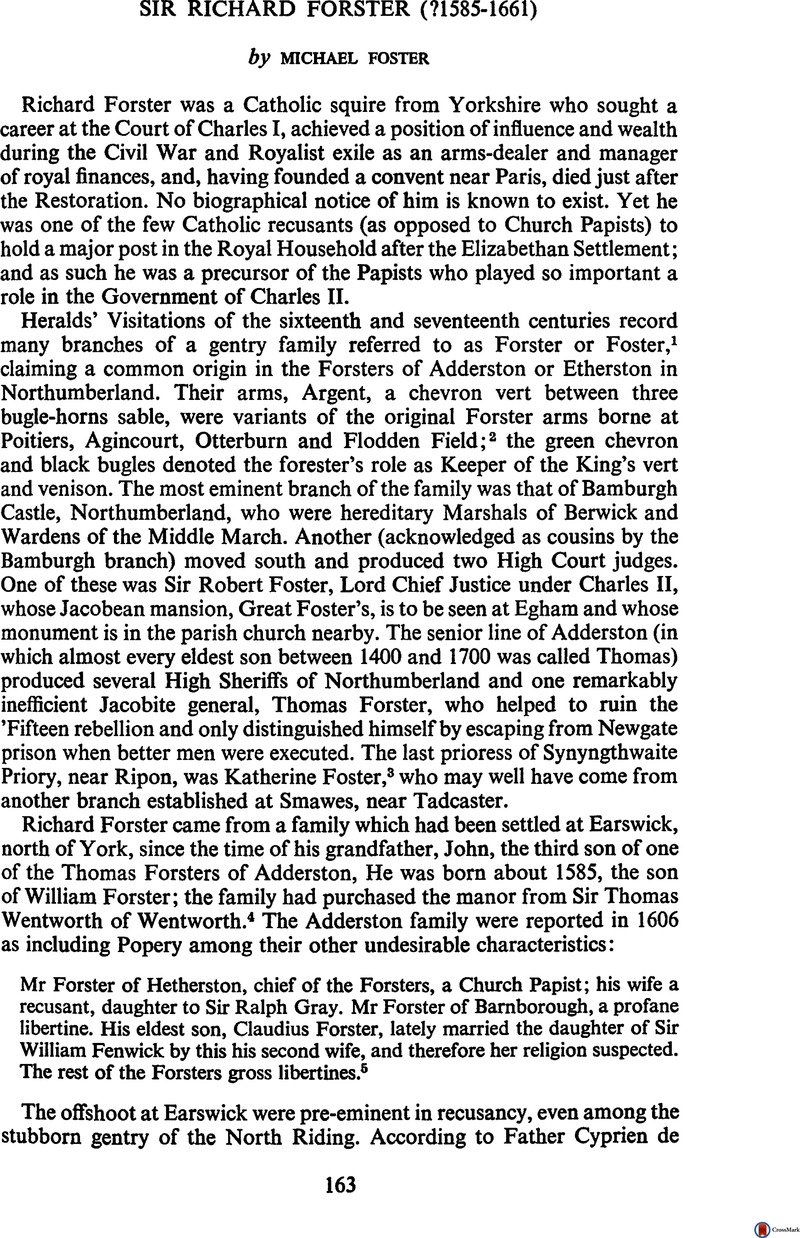No CrossRef data available.
Published online by Cambridge University Press: 11 October 2016

1 Joseph Foster, Visitations of Yorkshire. The name, however, it was spelt, seems to have been pronounced ‘Foster’. Thus, although Sir Richard normally spelt his name ‘Forster’, he was usually referred to in Court letters as ‘Foster’. Other members of his family spelt the name differently.
2 Joseph, Foster, A Pedigree of the Forsters and Fosters (1871); Harleian Society 81.Google Scholar
3 Dugdale, Monasticon 5, p. 463.
4 The Visitations of 1584 and 1612 record the family as of Earswick, but they seem to have sold the manor to Leonard Weddell in 1613: V.C.H. North Riding 2, p. 148.
5 C.R.S. 53, p. 151.
6 Cyprien, de Gamaches, ‘Memoirs of the Mission in England of the Capuchin Friars’, ed. Birch, T., in The Court and Times of Charles I (1848), 2, pp. 482–3.Google Scholar
7 Gillow, under Richard Langley. According to Dugdale's Visitation of Yorkshire (1665), the Langleys were also of Stainton and Sheriff Hutton, Yorks. A Thomas Langley was Cardinal and Lord Chancellor in the fifteenth century.
8 C.R.S. 53, p. 199; C.R.S. 5, p. 193. Isabel died on 3 December 1585.
9 C.R.S. 53, p. 277.
10 C.R.S. 55, pp. 220, 321; Anstruther, Seminary Priests 1, p. 123; Cyprien de Gamaches, op. cit, pp. 482–6. William Forster may have left England by 1607, because in that year it was his son who leased land near Earswick to Richard Darby (North Riding Quarter Sessions Records, 20 September 1607). William Forster was married three times, to Elizabeth Thweng, Isabel Langley and Margaret Booth, who was a first cousin of Eustace White, martyred in 1591.
11 State Papers, Committee for Advance of Money, pt 2, 875.
12 Cyprien de Gamaches, op. cit., pp. 482–6.
13 Cockayne, Complete Baronetage 3, p. 11; British Library Add. MS. 9354; C.R.S. 55, p. 482; C.R.S. 40, pp. 30–31; Foley 7, p. 273.
14 V.C.H. North Riding 1, p. 173.
15 Cyprien de Gamaches, op. cit., pp. 486–7.
16 C.S.P.D. Charles I (1625–26), pp. 17, 61, 63.
17 Ibid., p. 254.
18 Gordon, Albion, Charles I and the Court of Rome, p. 105.Google Scholar
19 Calendar of State Papers Venetian.
20 Arthur, Collins, Letters and Memorials of State (1746), 2, p. 666.Google Scholar
21 John, Graves, History of Cleveland, p. 225.Google Scholar
22 Aveling, Northern Catholics (1966), p. 238.
23 C.R.S. 53, p. 423.
24 Calendar of the Clarendon State Papers 1, no. 610; C.S.P.D. Charles I (1635–36), p. 52; C.R.S. 17, p. 269; C.R.S. 53, pp. 399, 423; Calendar of the Committee for Compounding, pp. 3193, 3215.
25 V.CH. North Riding 2, p. 303. This arrangement did not prevent Stokesley passing to his son and grandson.
26 C.S.P.D. Charles I (1636–37), p. 296.
27 Sir Richard Wynn is known to have retired in 1642; the date of Forster's appointment can only be presumed. The Queen's correspondence shows that he was handling her finances by the end of that year.
28 Wallace, Notestein ed., The Journal of Sir Simonds D'Ewes (1923), p. 295.Google Scholar The Treasurer-General's ‘Book of the Establishment’ (National Library of Wales, Wynnstay MS. 166) shows that in 1641 ‘Richard Fosseter’ was replaced as Sewer by one Morgan, This man, later a Cornet in the Parliamentary army, denounced Forster as a Papist in 1648 and sought the sequestration of his houses in Southwark (valued at £90 a year in 1652). Strangely, the attempt failed for lack of evidence. State Papers, Committee for Advance of Money, pt 2, p. 875.
29 Angliae Notitia (1669), p. 305.
30 Green, M. A. E. ed., Letters of Queen Henrietta Maria (1857), p. 155.Google Scholar
31 This document, a treasured family heirloom, still exists among the Collingwood Papers at Coughton Court, Warwickshire.
32 C.R.S. 55, no. 482. ‘Mr Fossiter's son with Lord Abergavenny's grandchild is educated by Jesuits at Stanley Grange, Derbyshire, belonging to Mrs Anne Vaux’: C.S.P.D. Charles I (1635), p. 420.
33 C.R.S. 17, p. 269.
34 Cockayne, Complete Baronetage 3, p. 11.
35 Calendar of the Clarendon State Papers 2, nos. 737, 136.Google Scholar
36 Possibly of the recusant family of Chaigley, Lancashire.
37 Calendar of the Clarendon State Papers 2, nos. 807, 892, 1172.
38 Bray, W. ed., ‘Private Correspondence between King Charles I… Sir Edward Nicholas… Sir Edward Hyde and Sir Richard Browne’, in Memoirs, illustrative of the Life and Times of John Evelyn (1818), vol. 2, pt 2, p. 201.Google Scholar
39 Ibid.
40 Calendar of the Clarendon State Papers 3, nos. 35, 63.
41 Ibid., no. 83.
42 C.R.S. 17, pp. 252–62. Lady Abbess Neville's description and chronology of events thirty years earlier is self-contradictory in some details.
43 C.R.S. 17, pp. 252–62.
44 Ibid.
45 Ibid.
46 Calendar of the Clarendon State Papers 2, no. 1527.
47 Dugdale's Visitation of Yorkshire, 1665; Foley 6, p. 36.
48 See above, n. 23.
49 Foley 6, p. 136. He is said to have been born in 1632 and brought up in London.
50 V.C.H. North Riding 1, p. 225.
51 Above, n. 23; Yorkshire Parish Register Society 7, pp. 6, 9, 72, 73.